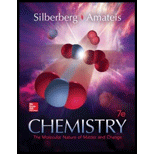
(a)
Interpretation:
The name and periodic table group number of each element present in Zinc oxide has to be given.
Concept Introduction:
Naming Binary Ionic Compounds:
For all ionic compounds, names and formulas give the positive ion (cation) first and the negative ion (anion) second.
For all binary ionic compounds, the name of the cation is the name of the metal, and the name of the anion has the suffix -ide added to the root of the name of the nonmetal.
In the naming of ionic compounds, the name of the cation is named first then anion is named.
In generally, binary ionic compound contains metal cation with non-metal anion. In the naming of binary compound, metal name is comes first followed by nonmetal.
Non-metals are named with suffix -ide root of the name of the nonmetal.
(b)
Interpretation:
The name and periodic table group number of each element present in Silver bromide has to be given.
Concept Introduction:
Naming Binary Ionic Compounds:
For all ionic compounds, names and formulas give the positive ion (cation) first and the negative ion (anion) second.
For all binary ionic compounds, the name of the cation is the name of the metal, and the name of the anion has the suffix -ide added to the root of the name of the nonmetal.
In the naming of ionic compounds, the name of the cation is named first then anion is named.
In generally, binary ionic compound contains metal cation with non-metal anion. In the naming of binary compound, metal name is comes first followed by nonmetal.
Non-metals are named with suffix -ide root of the name of the nonmetal.
(c)
Interpretation:
The name and periodic table group number of each element present in Lithium chloride has to be given.
Concept Introduction:
Naming Binary Ionic Compounds:
For all ionic compounds, names and formulas give the positive ion (cation) first and the negative ion (anion) second.
For all binary ionic compounds, the name of the cation is the name of the metal, and the name of the anion has the suffix -ide added to the root of the name of the nonmetal.
In the naming of ionic compounds, the name of the cation is named first then anion is named.
In generally, binary ionic compound contains metal cation with non-metal anion. In the naming of binary compound, metal name is comes first followed by nonmetal.
Non-metals are named with suffix -ide root of the name of the nonmetal.
(d)
Interpretation:
The name and periodic table group number of each element present in Aluminum sulfide has to be given.
Concept Introduction:
Naming Binary Ionic Compounds:
For all ionic compounds, names and formulas give the positive ion (cation) first and the negative ion (anion) second.
For all binary ionic compounds, the name of the cation is the name of the metal, and the name of the anion has the suffix -ide added to the root of the name of the nonmetal.
In the naming of ionic compounds, the name of the cation is named first then anion is named.
In generally, binary ionic compound contains metal cation with non-metal anion. In the naming of binary compound, metal name is comes first followed by nonmetal.
Non-metals are named with suffix -ide root of the name of the nonmetal.
Want to see the full answer?
Check out a sample textbook solution
Chapter 2 Solutions
Chemistry: The Molecular Nature of Matter and Change - Standalone book
 ChemistryChemistryISBN:9781305957404Author:Steven S. Zumdahl, Susan A. Zumdahl, Donald J. DeCostePublisher:Cengage Learning
ChemistryChemistryISBN:9781305957404Author:Steven S. Zumdahl, Susan A. Zumdahl, Donald J. DeCostePublisher:Cengage Learning ChemistryChemistryISBN:9781259911156Author:Raymond Chang Dr., Jason Overby ProfessorPublisher:McGraw-Hill Education
ChemistryChemistryISBN:9781259911156Author:Raymond Chang Dr., Jason Overby ProfessorPublisher:McGraw-Hill Education Principles of Instrumental AnalysisChemistryISBN:9781305577213Author:Douglas A. Skoog, F. James Holler, Stanley R. CrouchPublisher:Cengage Learning
Principles of Instrumental AnalysisChemistryISBN:9781305577213Author:Douglas A. Skoog, F. James Holler, Stanley R. CrouchPublisher:Cengage Learning Organic ChemistryChemistryISBN:9780078021558Author:Janice Gorzynski Smith Dr.Publisher:McGraw-Hill Education
Organic ChemistryChemistryISBN:9780078021558Author:Janice Gorzynski Smith Dr.Publisher:McGraw-Hill Education Chemistry: Principles and ReactionsChemistryISBN:9781305079373Author:William L. Masterton, Cecile N. HurleyPublisher:Cengage Learning
Chemistry: Principles and ReactionsChemistryISBN:9781305079373Author:William L. Masterton, Cecile N. HurleyPublisher:Cengage Learning Elementary Principles of Chemical Processes, Bind...ChemistryISBN:9781118431221Author:Richard M. Felder, Ronald W. Rousseau, Lisa G. BullardPublisher:WILEY
Elementary Principles of Chemical Processes, Bind...ChemistryISBN:9781118431221Author:Richard M. Felder, Ronald W. Rousseau, Lisa G. BullardPublisher:WILEY





